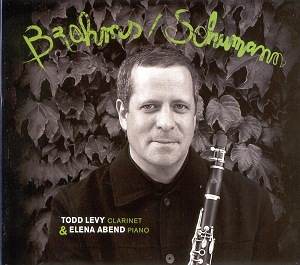Brahms and Schumann
are composers eminently suited to pairing
on disc. Todd Levy, principal clarinettist
of the Milwaukee Symphony Orchestra,
and his accompanist Elena Abend – both
new to me – are artists well suited
to the temperament of both composers.
From the outset of
Brahms’ first sonata a spacious view
is taken, despite the marking Allegro
appassionato. Indeed they realise
the contrasts between the sections of
the movement remarkably well, proving
in the process that appassionato
does not have to mean over the top or
overtly forceful. Their realisation
is that passion comes in waves; rightly
so, as this allows for the sense of
space and reflection that the more inward
passages contain to make the more outwardly
passionate ones carry the weight of
their emotional impact. In a twist to
the perhaps expected movement-ending
Brahms concludes on a thoughtful diminuendo,
the questioning aspect of which both
players capture. The second movement
continues in a similar vein, and, as
before, a sense of musical partnership
rather than mere accompaniment is palpable.
So too is the carefully wrought tone
of both instruments, where particularly
the clarinet’s lower register is played
to hang in the air effectively as the
tonal line progresses through a characteristically
Brahmsian microstructure of modulated
triads.
The tempo is picked
up in the third movement and a sense
of fluidity is shown in the playing
to echo the apparent ease of composition.
All of Brahms’ innate sense of structure
and pacing is to found in his late chamber
works, almost to a greater degree than
elsewhere in his output, and this performance
makes you aware of a very lyrical composer
working at full flood. The final movement
carries overtones of folk influences,
as well as projecting a notably more
optimistic voice. Indeed this is an
apt thought as more than once Levy’s
clarinet takes on a near-vocal quality
to telling effect.
All in all the difference
in mood that is apparent between the
two sonatas could not be more pronounced.
Whilst the second could be described
as shaded, maybe even guarded and insular
for the most part - it followed closely
after a series of personal setbacks
for the composer - the second sonata’s
three movements present an amiable face
to the world. In his notes Stephen Pettitt
comments on the ‘salon-style opening’
of the first movement – and there is
something of this that comes through
in the atmosphere of the recording,
with both instruments at a slight distance.
Though cleanly captured, they sound
as if caught in an amply dimensioned
drawing room. Abend’s touch as pianist
is sure, whilst Levy’s approach belies
a performer of purpose who puts the
composer first among his concerns. The
comparatively complex textures of the
middle movement come across well, by
dint of careful phrasing, before leading
to the variation-based finale within
which much is left implied by composer
and players.
The Schumann compositions
here are both more compact in form and
subtly different in mood from the Brahms
sonatas. Their character is more wistful,
particularly in the Fantasy Pieces,
and the Romances are cast with much
sense of mood about them. If my preference
is for an element of wonderment that
creeps into the Fantasy Pieces, it is
due in large measure to the careful
yet not over-studied phrasing with which
they are played. That said, I found
the tonal colouring brought to bear
within the Romances effective in providing
elements of suggestion. These factors,
along with a strong lyrical gift, are
perhaps what the two composers have
most in common, and it is right that
Levy and Abend allow such elements to
exist unhurried and unforced in their
performances. Most warmly recommended.
Evan Dickerson


